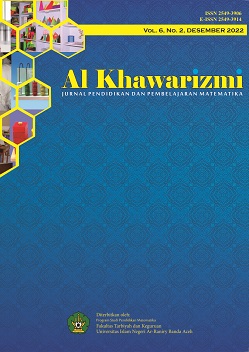Metacognitive Analysis of Students in Solving Mathematics Problem
DOI:
https://doi.org/10.22373/jppm.v6i2.15420Keywords:
Thinking Skills, Problem Solving, Metaconative LevelAbstract
This research is motivated by the lack of students' understanding of their thinking skills and students cannot determine the right strategy to overcome the problems encountered in solving mathematical problems. The purpose of this study was to find out how the metacognitive level of students in solving math problem solving problems in class IX.1 students of SMPN 26 Padang. This type of research is descriptive quantitative. The subject of this research is class IX.1 SMP Negeri 26 Padang. The instruments used are tests and interviews. The test is used to determine the metacognitive level of students in solving problem solving problems. Interviews were used to find out more about the metacognitive level in terms of students' understanding. The results showed that as many as 35.71% of students were at the metacognitive level of Tacit Use, as many as 35.71% of students had the metacognitive level of Aware Use, and as many as 28.58% of students had the metacognitive level of Strategic use. Students who have a high group metacognitive ability score in the classroom are at the Strategic Use metacognitive level. Students who have a moderate group metacognitive ability score in the class are at the Aware Use metacognitive level. and students who have a low group metacognitive ability score in the class are at the metacognitive level of Tacit Use.References
Akturk, A. O., & Sahin, I. (2011). Literature review on metacognition and its measurement. Procedia - Social and Behavioral Sciences, 15, 3731-3736. https://doi.org/10.1016/j.sdspro.2011.04.364.
Bulu, V. R., & Slamet, I. (2015). Peluang Ditinjau Dari Tipe Kepribadian Tipologi Hippocrates – Galenus Kelas Xi Mia 1 Sma Negeri I Soe. 3(9), 970–984.
Chauhan, A., & Singh, N. (2014). Metacognition: A Conceptual Framwork. International Journal of Education and Psyichological Research (IJEPR), 3(3), 21-22.
Handel, M., artelt, C., & Weinert, S. (2013). Assessing Metacognitive Knowledge: Development and Evaluation of a Test Instrument. Junal for Educational research . Vol. 5(2). Matter. 162-168
Hatip, A. (2016). Kemampuan Metakognisi Mahasiswa dalam Menyelesaikan soal-soal Persamaan Differensial Biasa. 3(4).
Jalali, Z., & Ikram, W. (2018). Zul Jalali Wal Ikram Universitas Negeri Malang Najmawati Azis Universitas Negeri Makassar. April, 810–820.
Laurens, T. (2010). Penjenjangan Metakognisi Siswa yang Valid dan Reliabilitas. Jurnal Pendidkan Dan Pembelajaran, 17(35), 201–213.
Mariam, S., Nurmala, N., Nurdianti, D., Rustyani, N., Desi, A., & Hidayat, W. (2019). Siswa MTsN Dengan Menggunakan Metode Open Ended DI. 3(1), 178–186.
Nugroho, A. A., Dwijayanti, I., & Atmoko, P. Y. (2020). Pengaruh Model Pembelajaran Berbasis Penemuan Dan Lingkungan Terhadap Kemampuan Pemecahan Masalah Matematika Melalui Meta Analisis. AKSIOMA: Jurnal Program Studi Pendidikan Matematika, 9(1), 147. https://doi.org/10.24127/ajpm.v9i1.2659
Nurjanah, A., I. Milama, B.Fairusi, D. (2017). Student Metacognitive Level on Solving Chemistry Problems. TARBIYA: Journal of Education in Muslim Society, 4(1), 63-73.doi10.15408/tjems.v4i1.5846.
Rambe, K. N., Sinaga, B., Masalah, P., Pembelajaran, M., Masalah, B., Belajar, G., & Anderson, M. (2015). Analisis kemampuan metakognisi dalam pemecahan masalah matematis pada pembelajaran berbasis masalah ditinjau dari gaya belajar. 2001.
Rinaldi. (2017). Kesadaran Metakognitif. Jurnal RAP UNP, 8(1), 79–87. ejournal.unp.ac.id/index.php/psikologi/article/download/7954/6073%0Ahttp://ejournal.unp.ac.id./index.php/psikologi/article/view/7954/6073
Sholihah, D. A., & Mahmudi, A. (2015). Keefektifan Experiential Learning Pembelajaran Matematika Mts Materi Bangun Ruang Sisi Datar. Jurnal Riset Pendidikan Matematika, 2(2), 175. https://doi.org/10.21831/jrpm.v2i2.7332
Wahyu Hidayat, R. S. (2018). Comparative histopathological study of pulmonary tuberculosis in human immunodeficiency virus-infected and non-infected patients. Tubercle and Lung Disease, 77(3), 244–249. https://doi.org/10.1016/S0962-8479(96)90008-8
Wahyuningsih, P., & Waluya, S. B. (2017). Unnes Journal of Mathematics Education Research Kemampuan Literasi Matematika Berdasarkan Metakognisi Siswa pada Pembelajaran CMP Berbantuan Onenote Class Notebook Abstrak. 6(1), 18–29.
Yildrim, S., & Ersozlu, Z. N. (2013). The Relationship Between Student' Metacognitive Awareness and their Solution to Similar Types of Mathematical Problems. Eurasia Journal of Education, 9(4), 411-415. doi:10.12973/euresia.2013946a.

